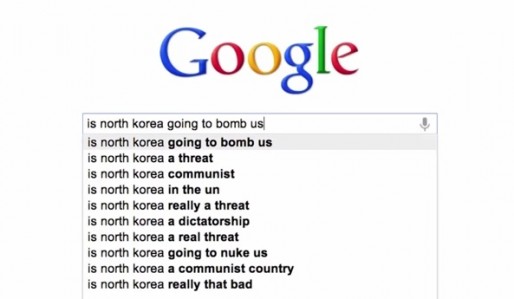This is one of a series of blog posts from the third ONA class of MJ Bear Fellows, three journalists under 30 who are expanding the boundaries of digital news. Applications are open to apply for this year’s fellowship until June 6. Fellow Kyle Stokes is the youth & education reporter at NPR member station KPLU in Seattle.
During one of Pyongyang’s more recent rounds of “crazy threats” — the Vlogbrothers’ Hank Green‘s words, not mine — Green did something really cool in his aptly-titled North Korea explainer vlog post, North Korea: Explained.
“Let’s see,” Hank says at the start of the video, “what the world wants to know about North Korea using our old friend, Google Autocomplete.”
Watch as Green types: Is North Korea … going to bomb us? appears as the first automatically-completed return in Google’s search bar. “They almost certainly will not,” Green answers. Is North Korea … a threat? “Yes, unfortunately.” Is North Korea … communist? “They’re kind of an absolute totalitarian multi-party hereditary military dictatorship …” And so forth, and in more detail, for nearly four minutes.
Not only can journalists learn learn a lot from the Vlogbrothers’ explainer videos, but I think journalists should be actively emulating their ability to distill complex information into digestible bites for an audience far more often than we currently do. The work of Hank Green and his brother John constitute a powerful case for why your newsroom’s next best investment might be a $50 webcam.
Take your first cue from Hank’s Autocomplete technique — a brilliant narrative device, to be sure, but there’s more going on here. The average Google user probably doesn’t know the answer to the query. But you don’t have to be a journalist to know the right question to ask. Hank Green taps into this curiosity of the zeitgeist, wielding it like a tool to winnow down an immense foreign policy subject into a bite-sized, four-minute video.
Our audience isn’t stupid, in other words. Yes, journalists at traditional media outlets writing about this story hit on many of the same critical points as Green. But Green is literally meeting the audience on its own search terms.
“Why,” many people asked a search engine, “does North Korea hate the U.S.?” Green doesn’t bury his answer at the end of a nut graf, in a sidebar piece, in the transcript of an interview or in a lecture captured on a webcam. Green directly answers the audience’s very direct question, making a one-way video into a two-way conversation between inquisitive equals. It’s harder to feel stupid when you’re getting a direct answer to your question, isn’t it?
For all of the curiosity our core audiences demonstrate — look no further than Google Autocomplete for proof — we journalists tend to leave a lot of valuable information in our reporters’ notebooks. But on topic after topic, from Egypt to Syria and the European debt crisis, Hank and John demonstrate that opening our notes and our expertise to our audience doesn’t have to mean extraordinary expenditures of our precious time. A few things to highlight:
- Your news organization doesn’t have to hire a camera operator to make explanatory videos work. The Vlogbrothers shot these themselves with webcams. They could have shot and edited these entirely on their smartphones if they wanted.
- Skip the natural sound flourishes or flashy graphics. John explains a topic as Byzantine as ballooning health care costs with only a few bar graphs, which he may have made in PowerPoint or a screenshot from a website. With minimal bells and whistles, Green keeps the audience engaged with jarring jump cuts and an electric pace.
- Hold the audience’s attention with fast-paced writing. Average time of a Vlogbrothers explainer post: Four or five minutes. It’s a good target when you’re making these videos. When Hank and John edit out their breaths, they’re buying not only precious seconds, but preserving every ounce of the natural energy and inertia in their writing.
I came by many of these takeaways the hard way, with several forays into the white board video genre during my time writing for the education blog StateImpact Indiana. I won’t say all of these videos were successful. Or dignified, for that matter. In my first attempt at an explainer video, I was so desperate to hold the viewer’s attention, I resorted to imitating barnyard animal noises — what was I thinking? — to make a point about school finance. To make matters worse, I droned on about how school budgets break down for ten wandering, excruciating minutes.
Still, the efforts paid off. As I touched on in my last post, the school board in an Indianapolis suburb played the video during their meeting. I learned valuable lessons from that first attempt. The next video came out shorter and snappier. The one after that was shorter and snappier still. Maybe by the fourth or fifth explainer vlog post, I had struck a workable balance between substantive content and watchable video.
No knocks on Vox or The Wall Street Journal or The Guardian or the many other news organizations already doing commendable explainer videos. But the Vlogbrothers have tapped into something particularly emulable. Every video they produce could have been produced easily by any a journalist who knows the issues well, without the need for flashy introductions or fancy graphics. Any journalist who wants to offer a direct response to a direct question can cobble together a quick explainer video.
The audience isn’t stupid, after all. They are just desperately looking for an answer.
 Fellow Kyle Stokes is the youth & education reporter at NPR member station KPLU in Seattle. He spent two-and-a-half years reporting on education for StateImpact Indiana, a collaboration of WFIU and Indiana Public Broadcasting.
Fellow Kyle Stokes is the youth & education reporter at NPR member station KPLU in Seattle. He spent two-and-a-half years reporting on education for StateImpact Indiana, a collaboration of WFIU and Indiana Public Broadcasting.

